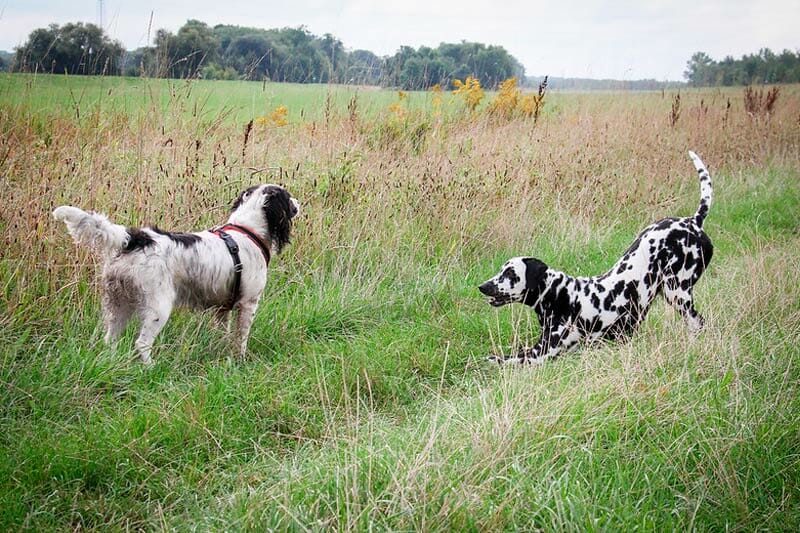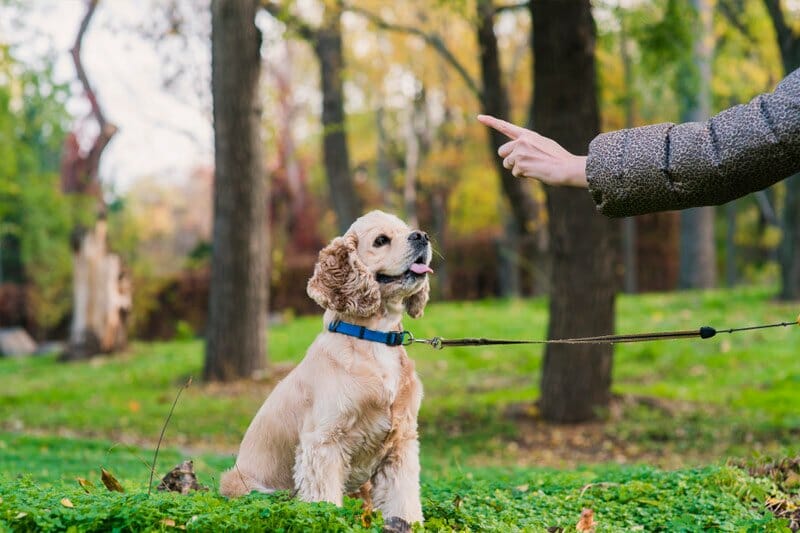Dogs and cats flourish when they’re allowed the freedom to roam and partake in fun activities in a backyard, without the constraints of a leash, which is essential for their happiness and health. If the idea of installing a regular fence doesn’t appeal to you, considering invisible electric fences for dogs might be an ideal way to keep your pets securely within the boundaries of your property.
An invisible pet fence, either wireless or underground fence, will cost you between $957 and $1,444, including professional installation, with an average cost of $1,200. The overall price of the invisible fence depends on how large the space you want to enclose. The typical cost is $1.75 to $2.75 per linear foot of boundary line or $2.25 per linear foot on average.
Pieces of information provided in this article are for dogs and cats or for pets in general.

What we cover
ToggleInvisible Fencing Cost
For most homeowners is cheaper and easier to install an invisible fence for their pets instead of building a traditional fence like wood, metal or vinyl. But how much will that project cost?
| National Average Cost | $1,200 |
|---|---|
| Typical Price Range | $957 - $1,444 |
| Lowest End | $550 |
| Highest End | $1,883 |
If you hire a professional fence company to install your pet fence, expect to pay around $1,200 total in material and labor costs. Though the typical price range is $957 to $1,444, the exact amount you pay will depend on the size of the property and the specific fencing system you choose.
A high-quality system from a premium brand or hiring an expensive contractor can boost your expenses to the highest or $1,883. We will talk about the most famous brands later in this article.
Electric Dog Fence Cost by Size
The table below presents the cost per linear foot, measured around the perimeter of the land area. Irregular shapes or difficult terrain may increase the final costs.
| Yard Size | Boundary *linear feet | Total Project Cost *approximate |
|---|---|---|
| 6,098 square feet (a small lot) | 312 | $702 |
| 12,632 square feet (an average lot) | 448 | $1,008 |
| 75,794 square feet (a large lot) | 1,100 | $2,475 |
The biggest advantage of an invisible fence, or electric fence, is that it can take on the size and shape which suits you the most. You can use one to surround your front yard, backyard, or property.
A wireless invisible fence system may have a limited reach, but you can always extend the boundary of a wired system simply by purchasing and installing extra wire.
No matter what type of invisible fence you choose, expect to pay between $1.75 and $2.75 per linear foot, and the average price will be $2.25 per linear foot, including labor and materials.
The average invisible dog fence cost can help you estimate the overall budget for your project based on size.
Factors That Affect the Invisible Electric Fence Cost
Always keep in mind that each detail could affect the overall project cost. How many pets do you have? Wireless or wired invisible fence? Special features that the fence needs can affect the invisible fence cost. Knowing the answer to these questions can help you estimate how much you will spend on the project.
Number of Pets
Usually, invisible fences come with only one collar, so you will have to buy another collar separately if you have multiple dogs or cats. Compatible collars are available at any retailer that sells invisible fences, including Amazon. The average cost of the receiver collar is $105.
Wired VS Wireless System
Wired Invisible Dog Fence
A wired dog fence, also known as an in-ground fence or underground fence, is installed so that wire is buried a few inches underground, and that way, you are marking the boundary you don’t want your pet to cross.
The invisible fence works as follows: A transmitter sends a signal along the invisible fence wire. Pet wears a collar receiver that reacts whenever your dog or cat gets close to the boundary line.
Most of the time, getting close to the wire will result in a chime from the pet’s collar. Your pet will learn to recognize the sound and turn around during the training period. But if the pet still crosses the boundary line, your pet will feel a mild shock, known as a static correction.

Pros of Wired Invisible Dog Fence
- Equipment like a receiver, transmitter, etc are cheaper than a wireless system;
- You can shape the boundary wire as needed (around a swimming pool, for example)
Cons of Wired Invisible Dog Fences
- Harder to set up than a wireless system, a professionally installed invisible fence is more expensive.
- Wire break is possible and can be difficult to fix.
- Tree roots can make installation difficult or even impossible in some parts of the yard.
Wireless Invisible Dog Fence
A wireless dog fence uses a central transmitter similar to the one in a wired system. Wireless systems project a radio signal to create a round containment zone instead of sending a signal along a boundary wire that you can adjust in size as needed.
And in this case, your pet would wear a receiver collar that responds to the signal. A warning tone comes along when your pet gets close to the boundary, and if your dog or cat leaves a predetermined safe zone, it will feel a static correction.
Pros of Wireless Invisible Dog Fence
- Portable and easy to set up.
- Problems with in-ground obstacles like tree roots and sidewalks are excluded.
Cons of Wireless Invisible Dog Fence
- You can’t modify the shape to fit your outer edges.
- It might be harder for dogs and cats to learn the circular boundary.
- Border can fluctuate because of the signal, which might further your pet.
- You won’t have to buy a wire, but the equipment like a transmitter/receiver is more expensive.
Brands of Invisible Fences
If you are a budget-conscious pet owner you can choose one of the affordable brands, or you have the opportunity to get some exclusive brands and more expensive brands that come with special features.
Some of the premium brands are available only for purchase from the manufacturer, and a certified installer has to set up the invisible fence. Because of professional installation, these systems are more expensive. The most famous premium brands are:
More affordable brands are available from Amazon and pet stores. These invisible fences usually feature less expensive equipment, and you can install them yourself. Below is the list of some of the best and DIY invisible fence brands:
GPS
With GPS, you can keep track of exactly where your pet is on your property, which can be really useful for larger spaces.
GPS systems can be also useful in cases of a power outage or fence malfunctions and that way pets will manage to get out, you’ll be able to find your dog or cat easily. You usually will pay more for a GPS-enabled system.
Instead of a radio signal, GPS is used in some advanced wireless invisible fences to keep the pet within the property. So even though you are using a wireless dog fence you can customize the boundary to fit your yard. This type is probably the most expensive option but it is extra convenient.
Protection Against Power Outage
Power outages are common due to lightning and similar. If your invisible fence stop working until the electricity comes back, which could take several days, your pet will have the opportunity to escape.
Fortunately, there are precautions you can take in a timely manner to prevent power outages from disabling your fence, such as:
- Do not rely on the home’s electricity system, use a solar charger;
- Have a backup source of electricity;
- Get a surge protector or in-ground metal grounding rods to get lightning protection.
Each of these protective features will raise the invisible electric fence costs, but these added measures could save you a headache in the future.
Extra Services
We already know that invisible electric fences don’t require as much maintenance as physical fences, but there are still some services related to invisible fencing for which you will have to or want to hire a professional.
Pet Training
Pet training is required so your pet can recognize the sound warning and avoid static correction. Many pet owners are able to train their pets themselves and that way save some money.
If you hire a company for the pro installation of your invisible fence, you might be offered pet training for an additional fee. But as an alternative, you can install the electric fence yourself, and then find a professional trainer with experience teaching pets how to respond to an invisible dog fence. The longevity of the training will determine the additional cost.

Customer Support
Professionally installed invisible fence (such as Invisible Fence Brand), comes with warranties and customer support in case you have problems or repairs for your electric fence in the future. This is a part of the whole package for the increased cost of high-quality invisible dog fence brands and doesn’t affect the overall cost.
Landscape Improvements
Sometimes you will have to rearrange your landscape a little bit to have your invisible fence boundary where you want.
For example, your electric fence-related landscaping needs could range from a small edit like digging up one section of a walkway or transplanting a tree to a full remodel.
Factor any renovation you think you will need into your budget, and the overall cost of the landscape renovation will depend on what work you’ll need and the labor rates of contractors in your area.
DIY Invisible Fence Cost
The invisible fence cost may reduce significantly if you DIY. Most homeowners find this project as a simple do-it-yourself task. A wired system will take more time and labor because of the buried wire, while a wireless system will take almost no work at all besides training and any additional services you may need.
On average, if you want to install an invisible dog fence yourself, expect to pay $238. You can buy an invisible fence kit for $54 and up to $780 for the most advanced systems.
Pros and Cons of Invisible Fences
Invisible pet fences are a controversial topic among many pet owners, other animals enthusiast, and veterinarians. Though electric dog fence is a cost-effective and convenient investment, some fear they can negatively affect pets. Before you decide to install an invisible fence, you need to weigh the pros and cons. I will present you with the most common.
Pros
- Cheaper than physical fences;
- Easier to install and maintain than traditional fences;
- Won’t block the view or interrupt landscaping;
- Pets can’t dig under or jump over the fence.
Cons
- Pets need time to get used to the boundary so it takes time to be effective;
- Doesn’t keep other animals, strays, or strangers out of your property;
- If batteries in the dog’s collar die or somehow power goes out they become ineffective;
- Even it is just a mild electric shock, the usage of pain and fear can lead to anxiety, aggression, and other behavioral issues for your dog or cat.
Cost of Invisible Fencing by Location
If you plan to install your own fence and train your own pet, you can count on the national average price. The cost of a DIY invisible fence kit should be about the same no matter where you live.
On the other hand, the price of the invisible fence project when you get into professional labor costs vary by location. In major metropolitan areas, hourly rates for an invisible fence contractor are higher than in rural regions. The costs for additional services like training of the pet, landscaping, will depend on labor rates where you live, too.
Final Thoughts
A professionally installed invisible fence is about $1,200, and the typical price can range from $957 to $1,444.
Take the average rate of $2.25 and multiply it by the size of the boundary you need in linear feet to figure out the price of your own project.
Instead, you could install your own fence for much cheaper. The equipment will usually cost around $238. Some models might cost as much as $780 or a little as $54. Depending on your property and pet’s specific needs, you might find that a more expensive containment system with special features could be worth the higher price tag.
FAQ's
Yes! Many reasons can contribute to this. Dead batteries, underground wire breaks, electricity break (that’s why the solar charger is recommended), or stubborn pets. All this can result in an escape, and when the dog or cat manages to escape, the boundary will shock them when they try to get back in your yard.
But don’t worry, escapes don’t happen so often, or invisible fences wouldn’t be so popular.
Usually, invisible fences are buried 1 to 3 inches underground
An invisible fence uses about as much electricity as a 5-watt nightlight which means $10 per year.













